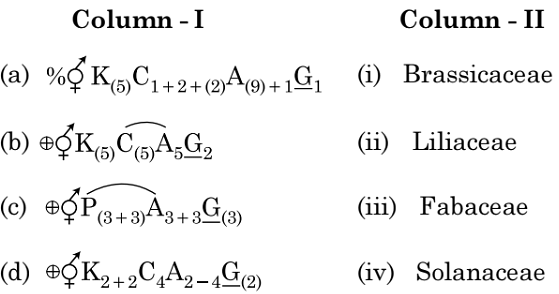Question
Biology Question on morphology of flowering plants
Match Column - I with Column - II.

Select the correct answer from the options given below.
(a)-(iv), (b)-(ii), (c)-(i), (d)-(iii)
(a)-(iii), (b)-(iv), (c)-(ii), (d)-(i)
(a)-(i), (b)-(ii), (c)-(iii), (d)-(iv)
(a)-(ii), (b)-(iii), (c)-(iv), (d)-(i)
(a)-(iii), (b)-(iv), (c)-(ii), (d)-(i)
Solution
Floral formulas serve as symbolic and numeric representations of a flower's various components, conveying essential information about the flower's structural characteristics. This includes details about the types and quantities of floral parts, the symmetry of the flower, the positioning of the ovary relative to other floral whorls, and relationships between different parts of the flower.
The following letters and symbols are commonly employed in floral formulas:
- Br (bracteate)
- K (calyx)
- C (corolla)
- P (perianth)
- A (androecium)
- G (gynoecium)
- G (superior ovary)
- G (inferior ovary)
- ♂ (male)
- ♀ (female)
- ⚥ (bisexual plants)
- ⊕ (actinomorphic flower)
- Z (zygomorphic flower)
- Fusion is denoted by enclosing the figure within brackets.
- Adhesion is indicated by a line drawn above the symbols of the floral parts.
Now, let's provide the floral formulas for three distinct plant families:
Fabaceae: The flowers in Fabaceae exhibit zygomorphic symmetry and are bisexual. The calyx is composed of five fused sepals, while the corolla is papilionaceous, consisting of one standard petal, two wing petals, and two fused keel petals. The stamens are diadelphous, and the gynoecium is monocarpellary with a superior ovary.
Solanaceae: Solanaceae flowers are actinomorphic and bisexual. The calyx features five fused sepals, and the corolla consists of five fused petals. There are five epipetalous stamens, and the gynoecium is bicarpellary and apocarpous with a superior ovary.
Liliaceae: Liliaceae flowers are actinomorphic and bisexual. The perianth comprises six fused tepals, arranged in two rows. There are six epipetalous stamens, and the gynoecium is tricarpellary and syncarpous with a superior ovary.
Brassicaceae: Flowers in Brassicaceae exhibit actinomorphic symmetry and are bisexual. The calyx consists of four sepals arranged in two rows (polysepalous), while the corolla comprises four petals (polypetalous). There are six stamens, arranged in two rows (tetradynamous), and the gynoecium is bicarpellary and syncarpous with a superior ovary.
So, the correct option is (B): (a)-(iii), (b)-(iv), (c)-(ii), (d)-(i)
